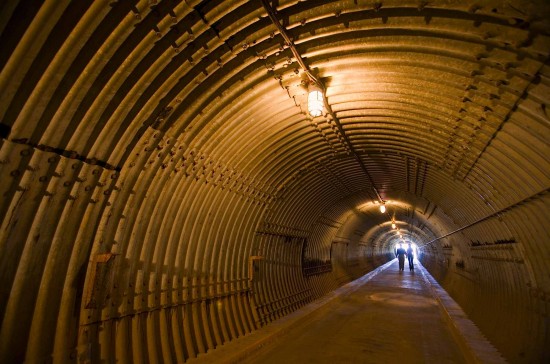It can be a bit creepy. It might induce claustrophobia if you think too much about its location deep underground. But it’s a unique piece of Cold War history that takes visitors back more than 50 years to the era of two superpowers and growing worldwide fear of nuclear conflagration.
The Diefenbunker, Canada’s Cold War Museum, sits in a rural landscape near the village of Carp, about 35 kilometres west of Ottawa. At first sighting it looks like a nondescript storage shed surrounded by a barbed wire fence and a sentry post. But walk through the entrance, along a lengthy blast tunnel until you’re stopped by two huge, bank vault doors and you know you’re in a unique place.
Originally called the Emergency Government Fallout Shelter, it was a top-secret project commissioned by Canadian Prime Minister John Diefenbaker in 1959 as a safe, secure government and military centre in the event of a nuclear attack on Canada. It was designed to hold as many as 535 people for up to 30 days.
A deep excavation was made at the site of an existing quarry and a four story, 100,000 square foot structure with 300 rooms was built of concrete and steel – enough steel for a 20 story building! The whole bunker was covered again by stone and dirt. Engineers estimated that the structure could withstand a five-megaton nuclear bomb, 250 times more powerful that Hiroshima. Completed in 1961, the shelter cost $41 million to build and equip.
The Cold War ended with the collapse of the Soviet Union but the Diefenbunker (so-named by a Toronto Telegram reporter who broke the story of its existence) continued to function as a military communications facility until it closed in 1994.
Now run as a private museum with some government and foundation support, the Diefenbunker is a fascinating look at Canadian history where visitors are suddenly thrust back to the 1950s and early 60s as soon as they enter the facility. There are guides as well as self-guided recorders to take visitors from room to room. The furnishings are much as they were 50 years ago.
Among the more interesting areas are the Bank of Canada vault where this country’s gold was to be taken in the event of an attack, the Cabinet War Room for emergency meetings (even with one of those James Bond red telephones), several high tech (well, high tech for the 60s) communication rooms for keeping in touch with the outside world and a fully equipped CBC radio broadcast studio.
Passing the decontamination area, visitors can see complete medical facilities, the large cafeteria and games room, dorms for personnel and even the modest suite designed to be used by the Prime Minister. Rumour has it that Mr. Diefenbaker refused to stay overnight in the bunker because no spouses were allowed.
At the end of the tour visitors can view several rooms where historical material related to the Cold War and its effects are on display. The museum trustees are expanding this area to include more photos, newspapers, film clips and memorabilia from the era.
The Diefenbunker is open year round. For more details, visit www.diefenbunker.ca
Photo Credits
“The Diefenbunker, Canada’s Cold War hide out” Courtesy of Ottawagraphy
“Diefenbunker sign” Let’s Go Ottawa
“The War Cabinet Room in the Diefenbunker” courtesy of John and Sandra Nowlan
“The Prime Minister’s Bedroom and Office in the Diefenbunker” courtesy of John and Sandra Nowlan






What an interesting place. Can’t believe I’ve lived in Canada for eons (and been to Ottawa several times) yet never knew about this. Thanks for telling us about it!
Sandra